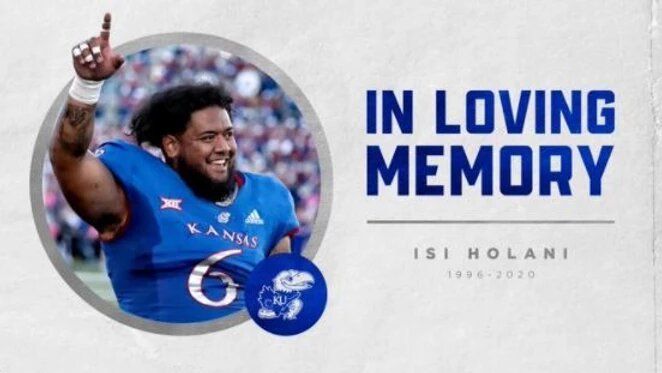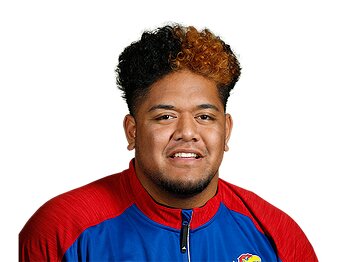This type of thing is happening way too often.
News of Isi Holani’s death at age 24 hit Hawaii hard on Saturday.
Hearing about the tragedy was eerily similar to at least three deaths of young football warriors in Hawaii in recent years — Daniel Te’o-Nesheim, Kona Schwenke and Simione Vehikite.
And always accompanying the story when it hits — no cause of death was given.
A defensive tackle, Holani played his high school football at Hilo and was named the Big Island Interscholastic Federation defensive player of the year in 2013. That was the season the Vikings won their first of seven straight league titles.

The Big Island’s Isi Holani died at age 24 on Saturday. He was a standout defensive tackle for Hilo High and the University of Kansas. (Photo from Kansas Jayhawks).
Holani, who was 6 feet 3 and 324 pounds in his three years of college football at the University of Kansas, was well-loved by his teammates and coaches at both levels of the game — as was reported by various media outlets. One of the kindest souls on earth,” former Jayhawks coach David Beaty told the Kansas City Star on Sunday. “His family has a one-of-a-kind spirit that Isi embodied daily.”
And let’s be clear here: Just because Holani died young does not mean there was any link to brain injury or the use of drugs as being involved in the cause of death. But those are the first things some people think of when they hear of young athletes — who at one point were in the middle of the high-pressure world of big-time football — dying.
In Te’o-Nesheim’s case, the New York Times and the Seattle Times reported detailed stories about his being posthumously diagnosed with Chronic Traumatic Encephalopathy due apparently to numerous concussions and that an autopsy confirmed that alcohol and pills were found in his system at the time of his death at age 30 on Oct. 27, 2017.
Te’o-Nesheim was a defensive end who played at Hawaii Prep before going on to the NFL with the Philadelphia Eagles and Tampa Bay Buccaneers.
Schwenke was a Kahuku defensive tackle who went on to play at Notre Dame and on NFL practice squads.
Schwenke’s death at age 25 on April 22, 2018, was attributed to drugs in his system, according to a coroner’s report received months later by the Honolulu Star-Advertiser — a fact that went unreported until now. As far as is known, there has been no link to brain injury in this case. The family has declined to speak about the autopsy.
Vehikite’s family is suing helmet manufacturer Riddell and other organizations such as his school — USC — and the NCAA, alleging that head trauma during his playing days in youth leagues and then at Kapolei High and with the Trojans contributed to mental illness and also his death (a suicide, according to at least one media outlet) at age 26 on May 8, 2017.
So (at least) four former athletes from Hawaii have died in a little more than three years — and all between the ages of 24 and 30. One player linked with CTE. Two linked with drugs in the system. One family alleging that repeated blows to the head led to their son’s eventual death.
And one that we don’t know yet how he died. It may be months before we find out. These are all tragedies, right? But what can be done?
The sport of football is working on making the game safer, but is enough being done? Or is it just too dangerous to risk having our youngsters play? Are there enough drug counselors and mental health services for players who leave the limelight only to find that they are now in a harder-than-expected real world with not enough skills to cope?
One way that would be a help to society in general, as was pointed out by a surfing promoter in a recent discussion, is to give out “mental health toolboxes” to students as young as kindergarten. That would entail coping skills taught by educators in a school setting and making it clear that it’s normal to get help while teaching others to not stigmatize it.
That conversation was loosely about Hawaiian surfing legend Sunny Garcia’s struggles with depression and his attempt at taking his own life at age 49 on April 29, 2019, that led to a coma that he came out of and is still recovering from.
The promoter who watched Garcia climb from a kid to a superstar believes that, in part, Garcia did not know how to handle going from that glorious life to one in which he was not anywhere near the top of his sport. The promoter also mentioned that there are likely many more in the surf world going through those same kind of mental health problems and don’t know where to go for help. Andy Irons, another Hawaii surfing legend, fits into that same category — drugs in his system at the time of his death at age 32 on Nov. 2, 2010, and a history of suffering from manic-depression.
How many young Hawaii former football players — and possibly athletes in other sports — are we going to lose? What kind of programs are in place for mental wellness, education and outreach for newly graduated college players or newly retired NFL players. Are there enough safeguards for them? Or are they going to fend for themselves in their own little brave new world?
There are no easy answers. But there are a lot of caring people in the world who can work together to find away to take better care of our Ohana in need.
And let’s pray that Isi Holani did not suffer from CTE or mental illness and did not turn to drugs before he died.
Top Stories
Related Post
Kamehameha Catapults To No. 1 In Bedrock Football Top 10;
Not everybody thinks Kamehameha is the No. 1 Hawaii high school football team at this point in the season. Some
Bedrock’s Friday Hawaii High School Football Scoreboard; All 5 Scores
Scores from all five games Friday in Hawaii high school football are in. The biggest game was No. 1 Kahuku
RIVALS WAIKIKI GAME OF THE WEEK: Saint Louis’ Hawaii Homecoming
RIVALS WAIKIKI GAME OF THE WEEK Editor’s note: For some video highlights of the game, scroll to bottom of story.
Keaau Cougars Football Team Page
Contents of the Keaau Cougars Football Team Page: >> Coverage of the 2022 Keaau Cougars football team >> Team page
COVID-19 Is Already Disrupting Hawaii High School Football Season
COVID-19 continues its nastiness. The virus that at one point seemed like it was under control is rearing its ugly
Punahou Buff ‘N Blue Football Team Page
Contents of the Punahou Buff ‘N Blue Football Team Page: >> Coverage of the Punahou Buff ‘N Blue football team
SEE: 5 Videos Of Waipahu’s 36-25 Victory Over Leilehua
—– When Division I Waipahu topped Open Division Leilehua 36-25 on Friday at Hugh Yoshida Stadium in Wahiawa, Bedrock Sports Hawaii
WATCH: Video Highlights Of Kahuku’s 32-7 Open Division State Semifinal
—– When Kahuku defeated Campbell 32-7 in the Open Division semifinals of the First Hawaiian Bank/HHSAA Football State Championships last
SEE: 10 Videos And A Photo Gallery Of Nanakuli’s 35-21
—– Note: This post has been updated to include bonus footage of seven Nacnac Productionz videos. —– When Nanakuli topped
Opinion: Hawaii High School Football Is Doubtful For The Fall
There’s nothing like high school football. Most of us know it is a great sport played by student amateurs. It’s
Kahuku Is No. 51 In The High School Football America
—– The two-time defending Hawaii Open Division football state champion Kahuku Red Raiders checked in at No. 51 in the
RECRUITING ROUNDUP: Texas Offers Kamehameha Freshman Malakai Lee; Saint Louis’
—– Texas football recruiting has been in the Hawaii news lately. First, earlier this summer, Kahuku’s highly sought-after linebacker Liona


